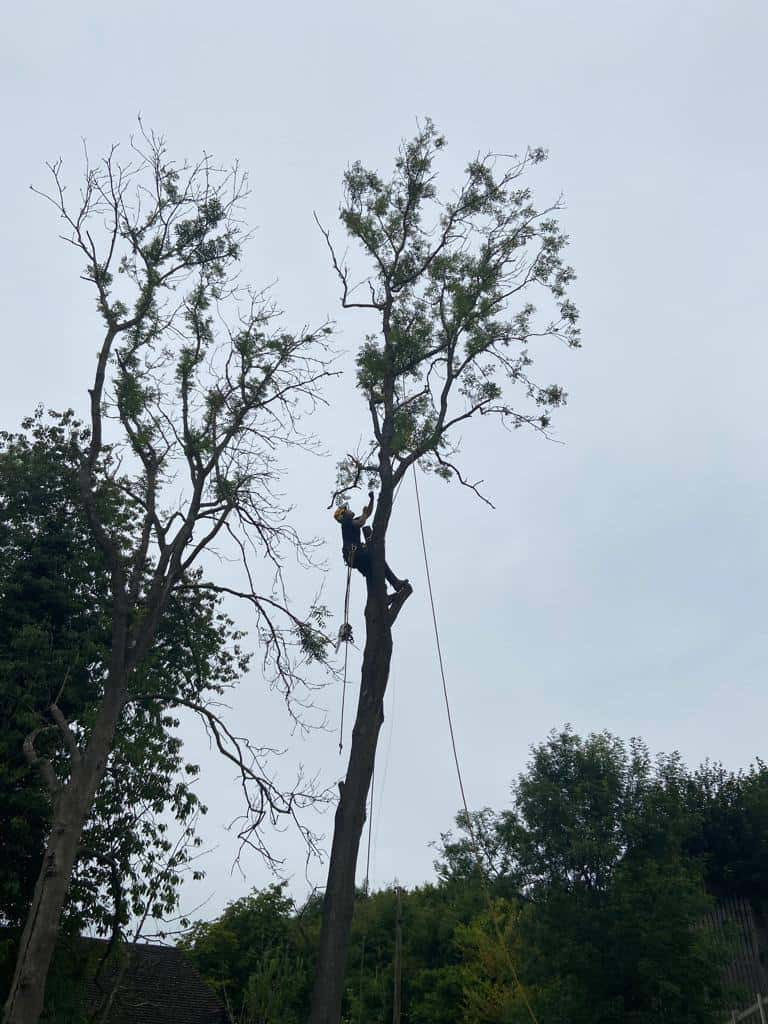Trees are not only an integral part of our landscapes but also essential to environmental health, offering shade, beauty, and oxygen. However, trees can face various threats—from disease and pest infestations to environmental stress—that put their health at risk. When a tree begins to show signs of decline, professional tree surgery can often provide a lifeline, helping to revive and restore it to full health. At Linton Tree Surgeons, we specialise in tree surgery in Linton, Cambridge, offering expertise to assess and treat trees under stress. In this post, we explore how tree surgery can be a vital intervention to revive ailing trees, ensuring their continued growth and vitality.
1. Diagnosing the Causes of Tree Decline
The first step in reviving a dying tree is to identify the root causes of its decline. Trees can suffer from a range of issues, including pests, fungal infections, nutrient deficiencies, and environmental stressors.
- Professional Assessment: Tree surgeons are trained to diagnose tree health accurately. By examining the tree’s symptoms—such as wilting leaves, discoloured foliage, bark damage, or thinning branches—a professional can determine the underlying issues causing distress.
- Soil and Environmental Testing: Sometimes, the cause of a tree’s decline lies beneath the surface. Tree surgeons may test the soil to check for nutrient imbalances or signs of root disease, which can help guide the necessary treatments.
With a thorough diagnosis, tree surgeons can create a targeted treatment plan to address the specific factors affecting the tree’s health.
2. Pruning to Remove Dead or Diseased Branches
One of the key techniques in tree surgery is pruning, which involves the selective removal of dead or diseased branches. This practice not only improves the tree’s appearance but also has vital health benefits.
- Preventing Disease Spread: Diseased branches can spread infections to healthy parts of the tree. By carefully removing affected branches, tree surgeons help prevent further contamination, allowing the tree to focus its energy on recovery.
- Encouraging New Growth: Pruning can stimulate new growth by directing the tree’s nutrients to healthier branches and encouraging the regeneration of leaves and buds. This targeted growth often signals the tree’s return to health.
Proper pruning can make a significant difference to a tree’s health, providing an immediate improvement in its appearance and reducing the risk of further decline.
3. Crown Thinning and Reduction for Improved Light and Airflow
Crown thinning and reduction are advanced tree surgery techniques that can benefit trees struggling due to overcrowded branches or poor airflow.
- Enhancing Light Penetration: By carefully thinning the crown, a tree surgeon allows more sunlight to reach the inner branches. This can strengthen the tree’s overall health, as sunlight is essential for photosynthesis, the process by which trees produce energy.
- Improving Air Circulation: Dense canopies can trap moisture, creating an environment conducive to fungal infections. Thinning the crown improves airflow, reducing humidity levels and the likelihood of disease.
Crown thinning and reduction can revitalise trees by improving their access to essential resources, supporting recovery and long-term health.
4. Soil Management and Nutrient Enrichment
Sometimes, tree decline is a result of nutrient-poor soil. Professional tree surgery can include soil management practices to ensure the tree has access to essential nutrients.
- Fertilisation and Mulching: Tree surgeons can apply fertilisers or organic mulch around the base of the tree to replenish nutrients. This provides the tree with the minerals needed to support growth, repair damaged tissues, and strengthen its root system.
- Soil Aeration: Compacted soil can restrict root growth and limit oxygen availability. By aerating the soil around the tree, tree surgeons improve oxygen flow to the roots, promoting a healthier root system and better nutrient absorption.
Soil management is a crucial aspect of tree health, enabling trees to recover from stress and rebuild their strength through improved access to nutrients.
5. Pest and Disease Management
Pests and diseases are common threats that can severely damage a tree’s health. Tree surgery includes methods for identifying and managing these issues to prevent further decline.
- Pest Control Treatments: A trained tree surgeon can identify signs of pest infestations, such as wood-boring insects or leaf-eating caterpillars. By using targeted pest control solutions, they can remove these threats, preventing further damage to the tree’s foliage and bark.
- Disease Treatment: Many trees are vulnerable to fungal infections, blights, and bacterial diseases. Tree surgeons can apply treatments to control these infections, helping the tree resist further damage and potentially recover from existing infections.
With effective pest and disease management, tree surgeons can alleviate the stress on ailing trees, allowing them to regain their health and strength.
6. Cabling and Bracing for Structural Support
When a tree’s structure is weakened, perhaps due to severe weather or internal decay, cabling and bracing techniques can provide the support it needs to remain stable.
- Supporting Weakened Limbs: Cabling involves installing flexible steel cables between branches to reduce movement during strong winds. This prevents further damage to weak or fractured limbs, giving the tree time to heal.
- Bracing for Trunk Stability: Bracing involves inserting rods through the trunk to reinforce stability. This can be essential for trees that have experienced structural damage but still show signs of vitality and potential for recovery.
Cabling and bracing can extend the lifespan of a tree, giving it the structural support it needs to continue growing while reducing the risk of branch or trunk failure.
Conclusion
Tree surgery is a valuable intervention for reviving trees that are showing signs of decline. With targeted practices such as pruning, crown thinning, soil management, pest control, and structural support, professional tree surgeons can help restore a tree’s health and vitality. At Linton Tree Surgeons, we provide expert tree surgery services in Linton, Cambridge, ensuring that your trees receive the care they need to thrive.
If you have a tree that appears to be struggling, don’t hesitate to contact us. Our team of skilled tree surgeons is ready to assess the situation and provide a tailored treatment plan to revitalise your tree and enhance the beauty of your landscape. Let us help you bring life back to your trees and enjoy a healthy, vibrant garden.
Call us on: 01223 919 495
Click here to find out more about Linton Tree Surgeons
Click here to complete our contact form and see how we can help with your tree needs.

